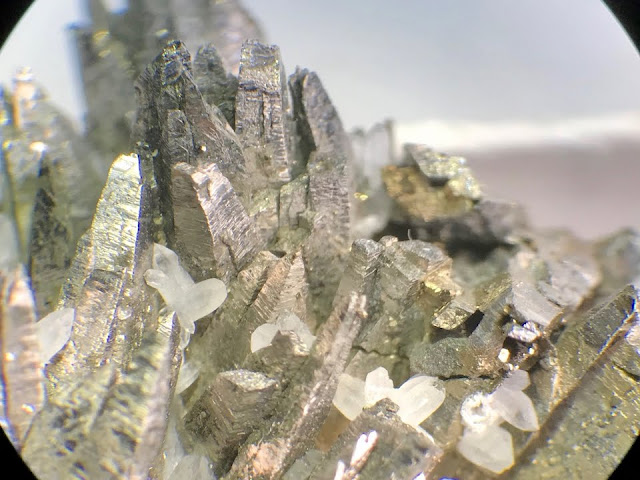柱状の硫砒鉄鉱 Prismatic Arsenopyrite
Quiruvilca mine, Santiago de Chuco Province, La Libertad, Peru (ペルー・キルビルカ鉱山)
標本幅 width 6 cm / 重さ weight 233 g
ほぼ硫砒鉄鉱(FeAsS)のみからなる群晶。少量の石英、微量の黄鉄鉱をともなう。ふつう硫砒鉄鉱は菱餅形の結晶をなすが、これはその一軸方向に異常に伸びた、長柱状の晶癖を示す。世界的には大分県尾平鉱山のものが有名で、まるで割り箸のような長さ 10 cm もの結晶が知られるが、この標本はせいぜい長さ 15 mm、幅 2 mm くらい。横に筋(条線)があって、ちょっと先細りになっている。一部表面が金色に輝いているが、これはおそらく黄鉄鉱かなにかの薄層だろう。
ここキルビルカは前に紹介したハッチンソン鉱(TlPbAs5S9)とおなじ産地。ペルーの業者のウェブサイトを見ていて、興味深い標本が2つあったのでまとめて注文してみた。ペルーの新聞紙に包まれて届いたときには、地球の裏側からよくぞやってきたなと感慨深かった。鉱物標本的には他に硫砒銅鉱(Cu3AsS4)の産地でもある。
A cluster of arsenopyrite with small amount of quartz and pyrite. Arsenopyrite usually forms a rhombohedral crystal, but this example is elongated in one direction. Such crystal habit is best known in Obira mine, Ogata town, Oita, Japan, where the length of "chopsticks" reaches 10 cm. Quiruvilca's example is not so long; they are up to 15 mm with 2 mm width. The prism has striation perpendicular to the elongated axis and rather resembles a spike. A part of the crystal surface shows a bronze luster, probably caused by a thin pyrite film.
The hutchinsonite specimen shown recently is also from the same locality. I ordered these two pieces at a website of a Peruvian dealer. They impressively arrived in a parcel wrapped with Peruvian newspapers after a long journey from the opposite side of the earth. Quiruvilca is also a well-known locality of enargite.
The circle's diameter is 20 mm. There is perhaps a tiny Japanese-law twinned quartz.
参考
つくば市・地質標本館所蔵の硫砒鉄鉱標本。大分県緒方町尾平鉱山産。尾平のものは単結晶が純粋に細長く伸びた感じで、キルビルカの晶癖とは厳密には異なるようにみえる。硫砒鉄鉱がここまで伸びるのは衝撃である。
Astonishingly elongated arsenopyrite from Obira mine owned by Geological Museum, Tsukuba city, Ibaraki, Japan. Obira's arsenopyrite looks to be a single crystal just elongated along one direction and, strictly speaking, to have a different crystal habit from Quiruvilca's example.
黄鉄鉱も細長く伸びることがある。釈迦内の標本を参照。
Pyrite is also rarely elongated in one direction. See the Shakanai's example.
アメリカ・スミソニアン博物館所蔵のペルー・キルビルカ鉱山産硫砒銅鉱標本。キルビルカでは古くは金・銀・銅を、最近は鉛・亜鉛も掘っている。鉱床は熱水鉱脈型で、中心から硫砒銅鉱ゾーン、鉛・亜鉛ゾーン、輝安鉱ゾーンのような帯状の分布をしているそうである(mindat の解説など)。
Enargite from Quiruvilca mine owned by Smithsonian Museum, USA.

